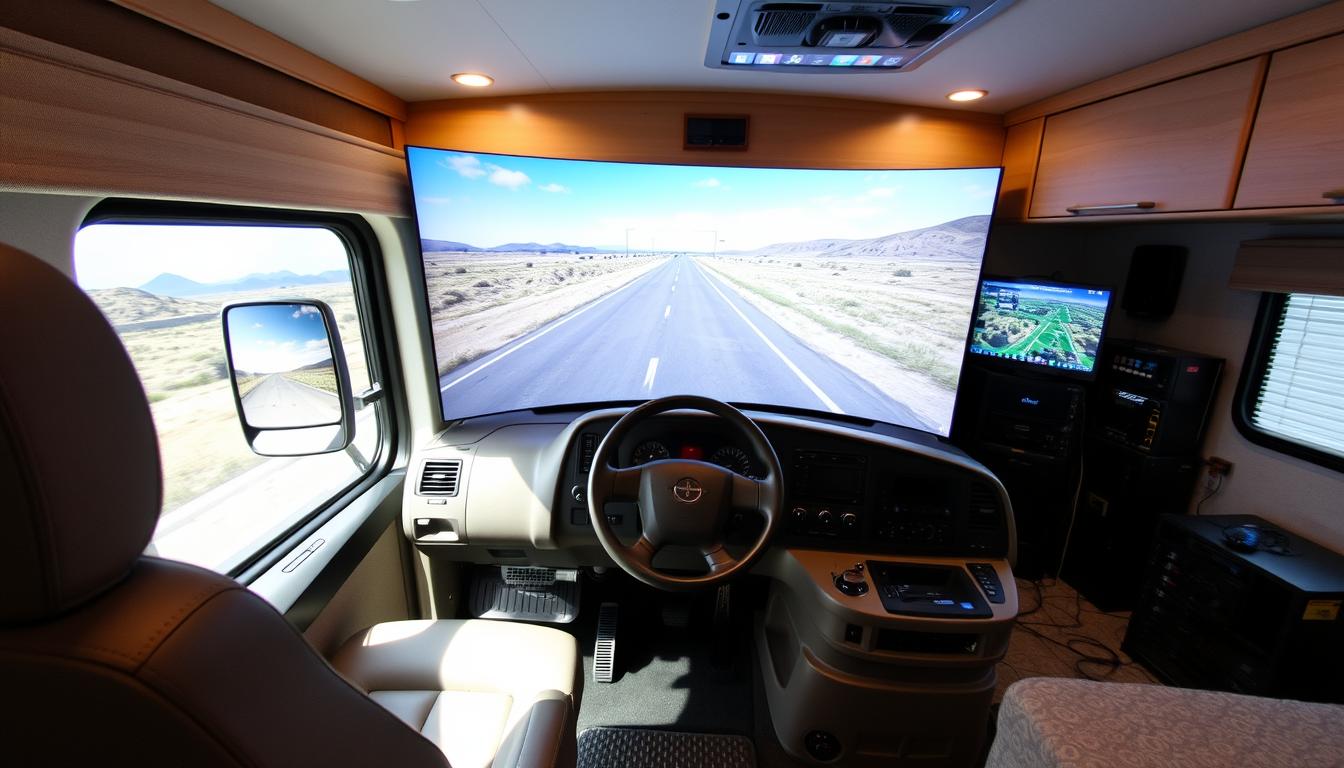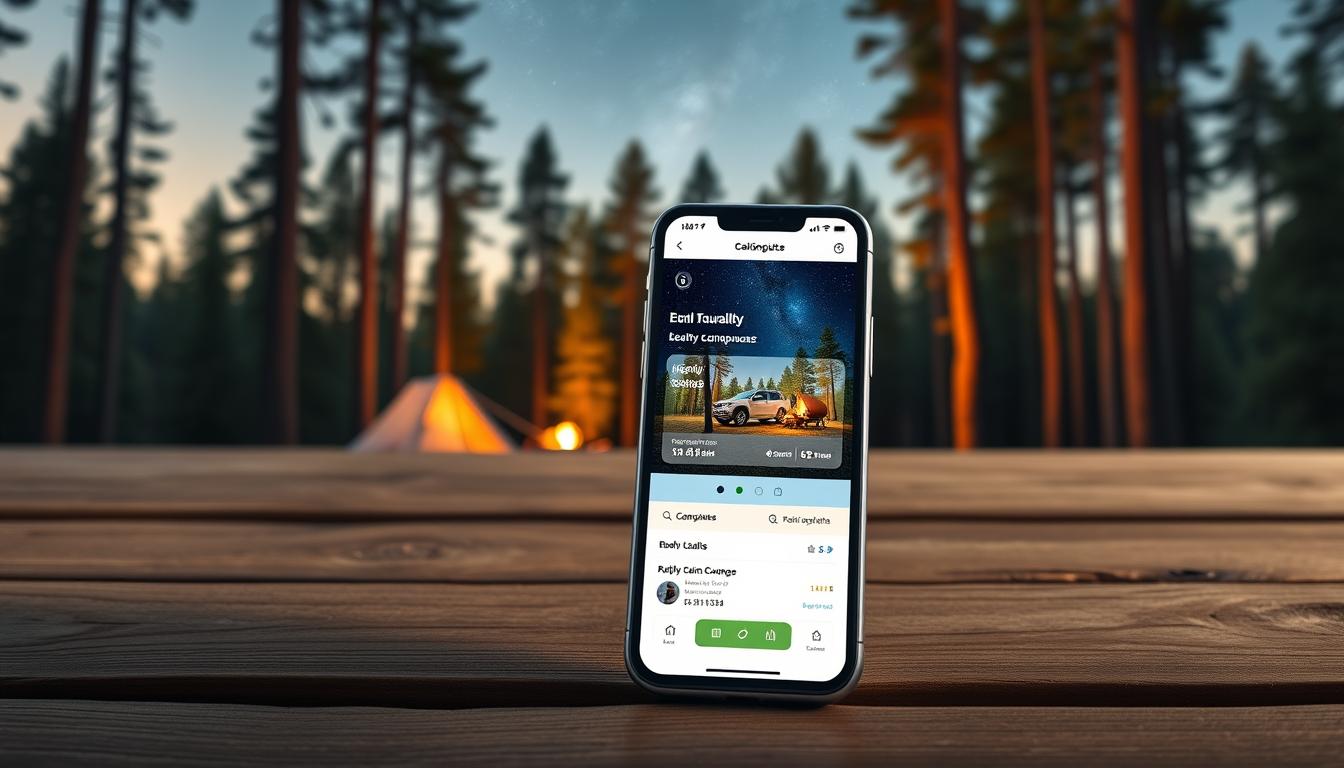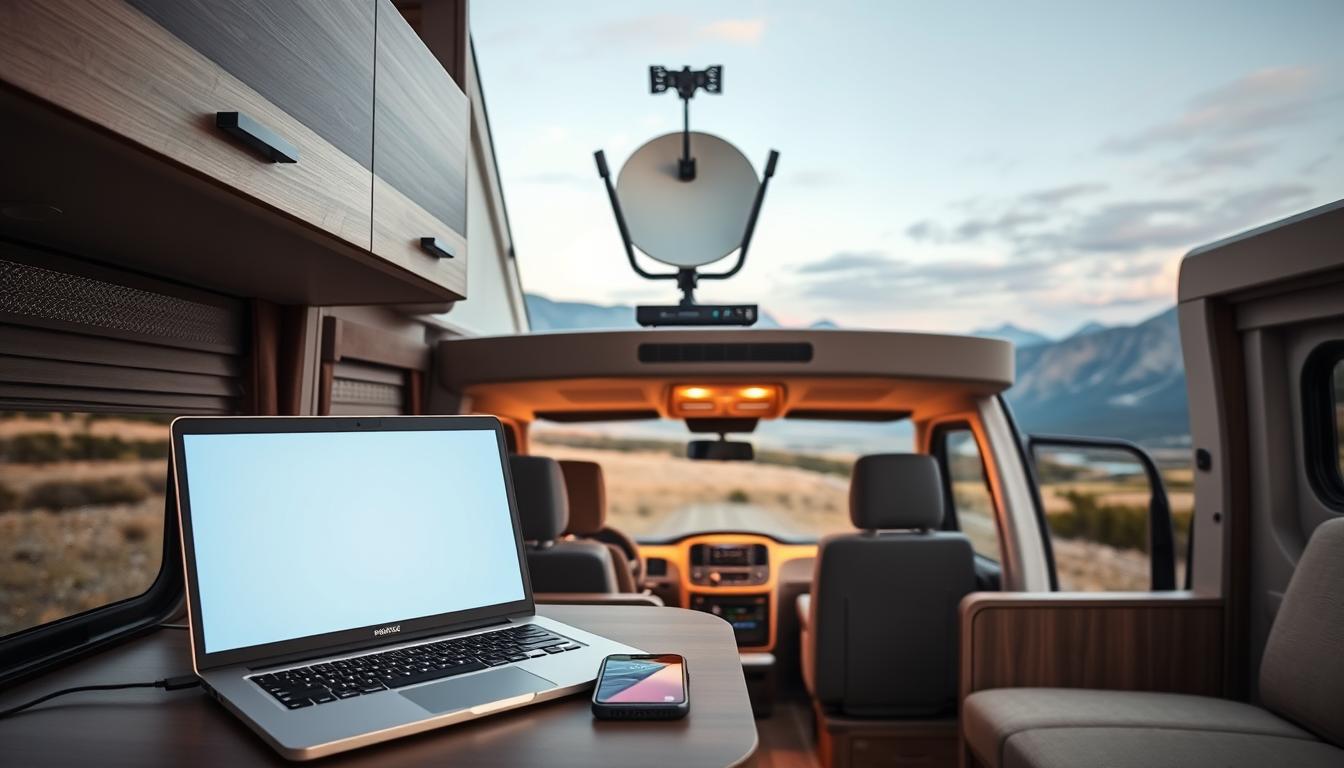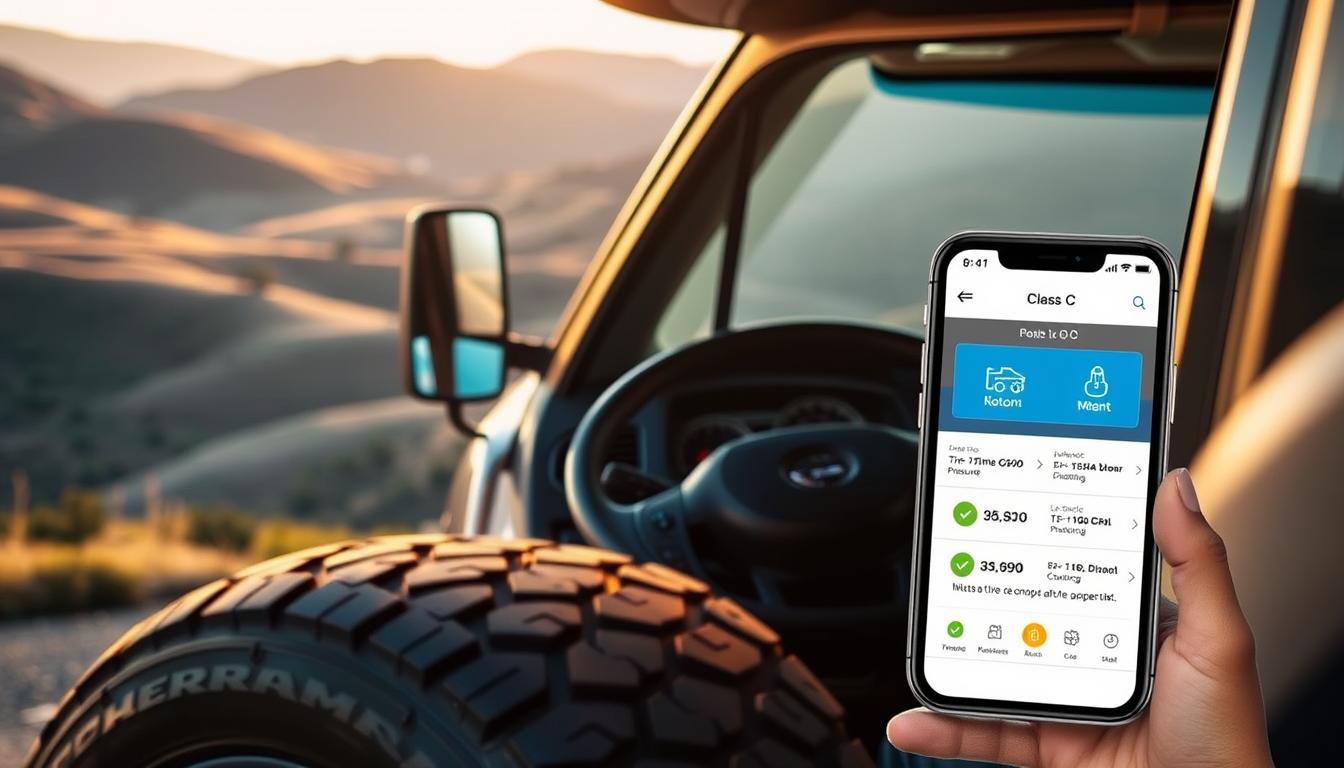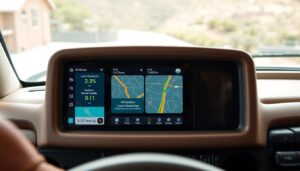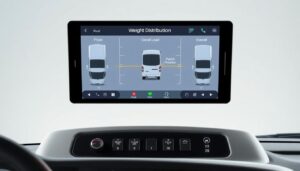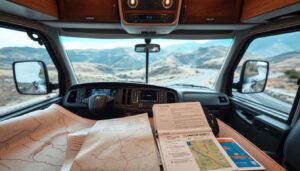Apps
Beginner RV driver tips, Class C motorhome training, Driving skills development, Learning to drive motorhomes, RV driving simulators, RV maneuvering practice, Simulated RV driving experience, Simulation for RV learners, Technology for RV training, Virtual driving practice
Hellen Louyse
0 Comentários
Driving simulators ideal for beginners learning to drive Class C motorhomes
Ever thought about how driving simulators can boost beginners’ skills in Class C motorhomes? With RV travel on the rise, learning to drive an RV is key, especially for newbies. Driving simulators use advanced tech to create a safe space for learning, helping new drivers feel more confident on the road.
This section explores how these tools are changing the way people learn to drive RVs. They prepare aspiring RV drivers for their future adventures.
Understanding Class C Motorhomes
Class C motorhomes are perfect for those who want comfort and convenience. They have a cab-over design, giving you more space to sleep and store things. These RVs are just the right size, not too big like Class A, but not too small like Class B.
Characteristics of Class C Motorhomes
Class C motorhomes are known for their layout and features. They are usually 20 to 35 feet long, offering lots of room without being too big. The cab-over area is great for extra sleeping or storage.
Many Class C motorhomes have slide-outs. These expand the living space, making them great for families or groups. This feature adds to their practical design.
Benefits of Driving Class C Motorhomes
Choosing a Class C motorhome has many advantages, especially for new RV owners. They are easy to drive and park, even in tight spots. Plus, they are more affordable than bigger RVs, making them accessible to more people.
These RVs are versatile, perfect for short trips or long journeys. They offer comfort and practicality, ensuring a great travel experience.
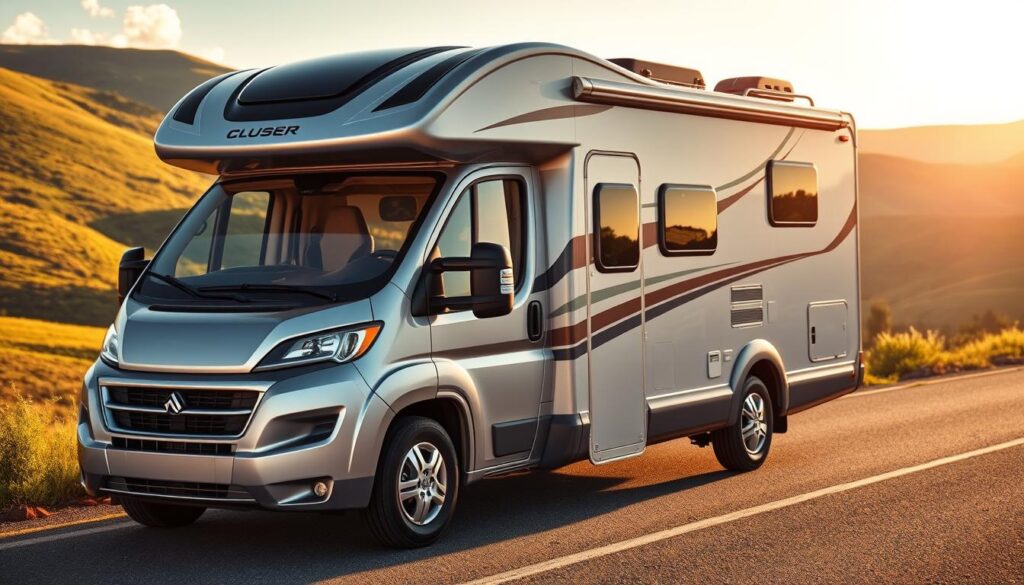
Importance of Learning to Drive an RV
Learning to drive an RV opens a world of adventure and exploration. It highlights the RV driving importance for those who love the freedom of RV travel. Mastering this skill lets people explore different landscapes and destinations.
It makes trips more exciting and memorable. Understanding how to handle a larger vehicle adds fun to trips. This makes the RV lifestyle even more enjoyable.
Freedom and Adventure on the Road
Driving an RV gives you unmatched freedom. You can choose your path and destinations without the usual travel limits. This freedom encourages a sense of adventure.
It lets drivers explore national parks, small towns, and scenic routes. Each journey becomes a unique story waiting to be discovered.
Safety Considerations for New RV Drivers
While RV travel is free, safety is crucial for new drivers. Knowing the vehicle’s size and weight is key to handling it well. New drivers need to learn safety rules specific to RVs.
This includes watching out for blind spots, understanding braking distances, and practicing defensive driving. Training programs can teach valuable skills for safe driving on the road.

Driving Simulators for Class C RV Beginners
Driving simulators are great for new RV drivers. They offer a safe place to learn without the stress of real driving. These tools help beginners get used to the challenges of driving a motorhome in different situations.
Advantages of Using Driving Simulators
RV simulators let you try out many driving scenarios safely. You can practice on different roads and learn how to handle emergencies. They also give you instant feedback to help you improve fast.
Practicing at your own pace makes you feel more confident. This is important before you start driving for real.
Types of Simulators Available for Training
There are many simulators to fit different learning styles. Here are a few:
- Software Applications: These programs are made just for RV training. They have realistic graphics and interactive lessons.
- Virtual Reality Platforms: These platforms make you feel like you’re really driving. They’re very immersive.
- Standalone Simulator Machines: These machines have everything you need for RV training. They’re designed to help you learn to drive safely.
Each type has its own special features. They help new drivers find the best way to learn. Using these tools, beginners can learn to drive an RV safely and effectively.
Overview of Top Driving Simulators for Beginners
Choosing the right driving simulator is key for beginners learning to drive Class C motorhomes. There are many options, from top driving simulators for RV training to RV simulator software with realistic environments. These tools offer fun and valuable skills to help new drivers learn RV navigation.
Simulator Software Options
Several software options are known for their high-quality graphics and easy-to-use interfaces. Programs like Euro Truck Simulator 2 and American Truck Simulator offer realistic driving experiences. They are great for training and allow users to customize their environment to look like an RV.
Hardware Recommendations
Good simulator hardware is crucial for a great experience. High-quality equipment can greatly improve training. Here are some recommended items:
- Steering Wheels: Brands like Logitech and Thrustmaster offer durable options that improve control.
- Pedals: Look for pedal sets with realistic motion; Fanatec has some excellent products.
- VR Headsets: For a fully immersive experience, consider using Oculus Rift or HTC Vive.
With the right hardware and software, learners can improve their driving skills. This ensures a smooth transition to real-life RV driving. Knowing these options helps beginners make the best choices for their RV driving journey.
Benefits of Using Driving Simulators Over Traditional Lessons
Driving simulators have big advantages over traditional lessons. They let you learn in a safe place without the stress of real driving. This helps beginners get better and feel more confident when driving a Class C motorhome.
Safe Learning Environment
For new drivers, real driving can be scary and slow learning. Simulators remove these fears, giving a safe space to make mistakes and learn. This is especially helpful for those who want to practice driving skills without risk.
Cost-effectiveness
Simulators are also cheaper than traditional lessons. Lessons can cost a lot, including fees for instructors, fuel, and renting a vehicle. Simulators are a one-time buy that you can use over and over again. This saves money and lets you practice whenever you want.
In short, simulators offer a safe and affordable way to learn how to drive. They are perfect for those who want to save money and learn at their own pace. For more info on simulators, check out this resource.
| Feature | Driving Simulators | Traditional Lessons |
|---|---|---|
| Cost | One-time purchase, no ongoing costs | Ongoing fees for lessons and rentals |
| Safety | Zero risk of accidents | Potential for real-world hazards |
| Flexibility | Practice anytime, anywhere | Dependent on instructor availability |
| Learning Pace | Self-paced learning | Instructor-led pace |
| Realism | Advanced simulation technology | Real-world experience |
Features to Look for in a Driving Simulator
Choosing the right driving simulator is key for mastering RV driving. Look for features that make learning easier. Realism and easy-to-use interfaces help beginners focus on driving skills.
Realism and Graphics Quality
Realism in driving simulators is crucial. High-quality graphics make road scenes, weather, and vehicle movements look real. This realism helps learners understand and adapt to real driving better.
Choosing simulators with top-notch graphics lets learners dive deep into training. It makes the learning experience more immersive.
User Interface and Ease of Use
A user-friendly simulator is vital for beginners. An easy-to-use interface lets learners focus on driving, not controls. Features like clear instructions and easy options make simulators more functional.
This approach helps learners move smoothly from simulation to real driving. It makes learning more effective.
How Driving Simulators Enhance RV Driving Skills
Driving simulators are key for improving RV skills. They help beginners get used to the size of Class C motorhomes. It’s important to know how these big vehicles handle.
Simulators let users learn at their own speed. This makes it easier to get the hang of driving a big RV.
Adapting to RV Dimensions and Handling
Class C motorhomes are much bigger than regular cars. You need to know how to drive them well. Driving simulators help you understand how to move around in these big vehicles.
They let you practice without the stress of real driving. This lowers the chance of accidents when you’re actually driving.
Practicing Maneuvering Techniques
Learning to turn, back up, and park is key for new RV drivers. Simulators let you practice these skills over and over. This builds muscle memory.
As you try different driving scenarios, you become more confident. This prepares you for the challenges of driving on the road. Using simulators makes you feel ready for the open road.
Combining Simulated and Real-life Driving Experience
For new RV drivers, mixing simulated practice with real driving is key. A balanced training plan helps move from the safety of a simulator to real road challenges. This method builds skills and confidence.
Creating a Balanced Training Routine
Creating a good training plan means switching between simulators and real driving. Simulators let learners practice skills like parking and turning without the stress of real roads.
- Start with several sessions of simulated practice to understand driving mechanics.
- Gradually move to short trips in a real RV for hands-on experience.
- Evaluate progress regularly to ensure skill retention.
Benefits of Hands-On Experience with Real RVs
Simulated practice is great, but nothing beats driving a Class C motorhome. Driving a real RV helps get used to its size, weight, and handling. It also improves muscle memory and shows what driving on different terrains feels like.
“Real-world driving experience, paired with simulated training, creates a comprehensive learning environment for prospective RV drivers.”
In summary, combining simulated and real driving training is the best way for new drivers. It sets them up for safer and more fun travel.
Safety Tips for New RV Drivers
Driving an RV opens up a world of freedom and adventure. But, safety must always be a top priority. By following key RV safety tips, you can greatly lower the risks of RV travel. Knowing how to do pre-trip checks and understanding RV safety systems is essential before you hit the road.
Pre-Trip Inspections
It’s important to do a thorough check before you leave. Make sure to check tire pressure, fluid levels, and that all lights are working. A checklist can help you not miss anything important. Here are some key things to check:
- Tire pressure and condition
- Engine oil and coolant levels
- Brakes and emergency brake functionality
- Lights and turn signals
- Hitch connections and weight distribution
Understanding RV Safety Systems
Knowing about RV safety systems is crucial for new drivers. Features like anti-lock brakes and electronic stability control make driving safer. By understanding these systems, you can drive more safely and confidently.
Common Challenges New RV Drivers Face
Driving an RV is different from driving a car. It requires new skills and awareness, especially for turns and road conditions. Knowing these challenges can make driving safer and more confident.
Navigating Turns and Corners
Turning in an RV is harder than in a car. RVs are longer and wider, so drivers need to plan and make wider turns. It’s important to signal early and check mirrors often for safe turns.
Practice helps develop the needed awareness. This way, drivers can avoid obstacles like curbs and other cars.
Adapting to Various Road Conditions
As an RV driver gets more experience, adapting to road conditions becomes key. Things like steep hills and changing weather can affect how the RV handles. It’s important to slow down on downgrades and accelerate slowly on inclines.
Being aware of crosswinds is also crucial, especially on highways. In tight city areas, drivers need to be very alert and flexible. Always checking the road helps avoid dangers.
Community Resources for New RV Drivers
New RV drivers can find lots of help from community resources. These resources offer important info and support. They help build confidence and knowledge in the RV lifestyle.
Online Forums and Support Groups
Online support is key for RV drivers. Forums and social media groups help newcomers connect with seasoned RVers. They can ask questions, share stories, and learn from others. Some top online spots include:
- RV.net Forum – A place for all RV-related discussions.
- Facebook Groups – Many groups offer advice and support.
- Reddit – Subreddits like r/RVliving share RV experiences and tips.
Driving Schools Specializing in RV Training
RV training schools are vital for new drivers. They offer hands-on training for RV driving. Learning from experts reduces risks and boosts driving skills. Some top schools are:
- The Wiser Driver Driving School – Offers detailed RV training programs.
- RV Safe – Focuses on safe driving and on-road training.
- Emergency Vehicle Operations Course – Provides training for large vehicles, including RVs.
Expert Advice from Professional RV Instructors
Learning to drive an RV can be thrilling but also scary, especially for newbies. Getting advice from expert RV instructors can really help. They share their knowledge and skills, making you safer and more confident on the road.
Insights from Experienced Drivers
Seasoned RV drivers stress the need to know your vehicle’s size. Practicing how to move it helps you control speed and direction better. They also teach about staying comfortable, using mirrors right, and adapting to different driving situations.
Learning from those who have been there before can make you a better driver. It helps you move forward faster.
Tips for Confidence Building on the Road
Getting better at RV driving takes practice and knowing safety rules. Start with short trips in places you know well, then move to harder routes. This helps you feel more at ease.
Being part of a supportive community and sharing your experiences can also boost your confidence. Remember, it’s about getting better with each trip, not being perfect right away.
Conclusion
As we conclude this RV driving training summary, it’s key to note the many advantages of simulators for new RV drivers. Simulators let beginners get used to RVs’ size and how they handle in a safe space. This virtual practice boosts confidence and prepares them for real driving.
By mixing simulation with actual driving, learners become well-prepared for the road. This method also teaches safe driving habits. It helps ensure that new RV drivers stay safe and protect others on their travels.
For any future RV driver, practice and learning never stop. Using simulators along with real driving makes for a great RV travel experience. It sets the stage for a fun and safe journey on the road.
FAQ
What are the benefits of using driving simulators for beginners learning to drive a Class C motorhome?
Driving simulators are great for beginners. They let you practice driving in a safe space. This boosts your confidence and reduces stress before you start driving for real.
They also mimic different driving situations. This includes steep hills and busy city streets. These can be tough for new drivers to handle.
How do Class C motorhomes differ from other types of RVs?
Class C motorhomes have a cab-over design. This design makes them more spacious and comfortable. They are also more affordable and easier to drive than Class A RVs.
They offer a good mix of affordability, ease of use, and versatility. This makes them a popular choice for new RV drivers.
What are the key safety considerations for new RV drivers?
New RV drivers should always check their RV before driving. This includes checking tire pressure, fluid levels, and lights. Knowing how to use RV safety systems is also key.
This knowledge helps prevent accidents and ensures safe driving. It’s important for all new RV drivers.
Can driving simulators really replace traditional driving lessons?
Driving simulators can’t replace real lessons entirely. But they have many benefits. They offer a safe place to learn and are more affordable.
They let you practice driving skills over and over. This helps you learn faster before you start driving for real.
What features should I look for in a driving simulator for RV training?
When choosing a driving simulator, look for realistic graphics and audio. Also, check the variety of driving scenarios and the user interface. These features make learning more enjoyable and effective.
How can driving simulators help improve specific RV driving skills?
Driving simulators help you practice important RV skills. This includes backing, turning, and parking. These skills are crucial for driving a Class C motorhome.
By practicing these skills, you build muscle memory and confidence. This is essential for safe driving on the road.
What are the common challenges faced by new RV drivers?
New RV drivers often find it hard to navigate turns and corners. They also struggle with adapting to different road conditions. This includes crosswinds and steep grades.
Using simulators and training can help you overcome these challenges. It builds your skills and confidence.
What types of community resources are available for new RV drivers?
There are many online forums and support groups for new RV drivers. They offer a place to ask questions and share experiences. You can also join specialized driving schools for personalized instruction.
These resources help you learn and grow as a driver. They provide valuable support and guidance.
What advice do professional RV instructors offer to beginners?
Professional instructors stress the importance of safety and awareness. They also advise overcoming driving anxiety. Learning from experienced drivers can greatly improve your skills and confidence.
